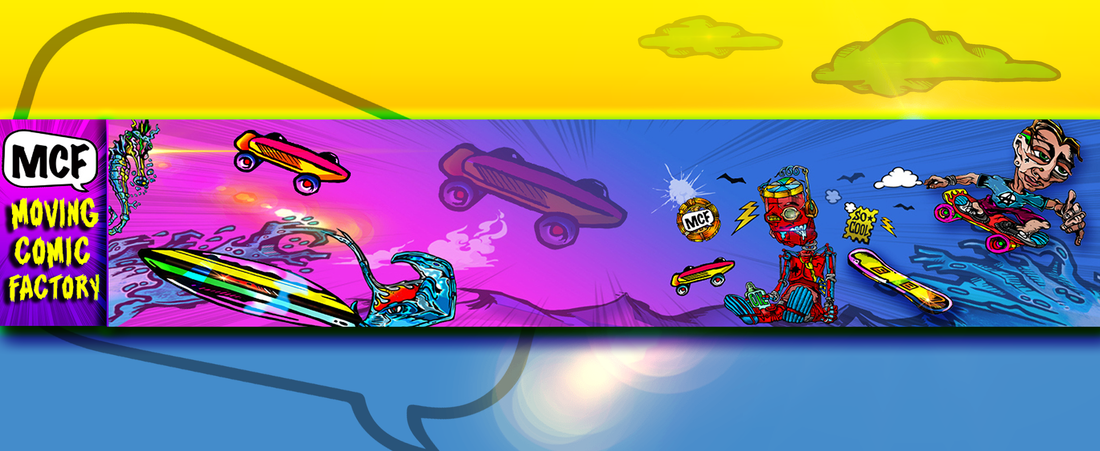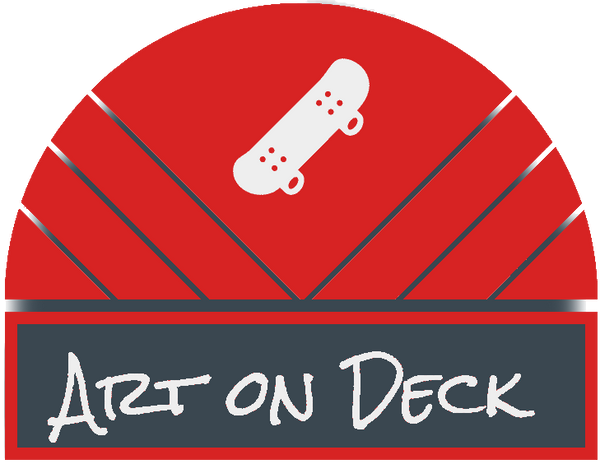
Moving Comic Factory (MCF) - A Skateboard Artist Exploration
Share
Moving Comic Factory (MCF) - A Skateboard Artist Exploration
|
When I discovered @movingcomicfactory, I was immediately captivated by the skill and detail-oriented nature of Vince's aka MCF's art. I loved how the images were larger than life and extreme, with vividly colorful backdrops. The fun part about MCF designs, is that they are just that - fun and extreme and wild, in fact you might just discover new details when you take another look. The cool thing is that MCF not only does art for skateboards, but also surfboards and kayaks! Come meet MCF this July, 2024 in Mississauga Ontario, where Art on Deck is hosting his amazing talent at this extreme sports festival - Jackalope Mississauga. We hope to see you there!
|
|
Moving Comic Factory: An Interview Q: How were you first introduced to skateboarding? What was the context and environment you found yourself in at that time? A: When I was about 12, I lived in the High Park area of Toronto with my folks and I had an old school yellow 'banana deck' with soft wheels, of all things. For street pranks I left the trucks loose, but one day I decided to be a hero and fly down the animal zoo road in High Park - which is a good steep road, and not too smooth in some parts. The trucks of course were NOT adjusted for high speeds. I hit a crack in the road, and went air-borne. The crowd (and animals) watched me crash land and use my elbow as a break at 50kph. That left a hole in my left elbow and other parts. Took a while to recover from that trick! lol
Q: How would you compare the perceptions and popularity of skateboarding when you were first introduced to it, with the way it is now? A: For my era, being the late 70s - skateboarding "was" a crime, it was the sort of frowned upon thing if kids were doing tricks in public park areas, or empty kiddie swim pools - they were often chased out by guards, etc. It was cool, rebellious and often looked like the 'bad kids' ride skateboards, which was fine with me. Today it's an Olympic sport, and high fashion practically. There are schools dedicated to teaching and using the skate deck as a legitimate art form. So it has certainly come a long way.
Q: Where do you see skateboarding going into the future – will it become more popular and mainstream with skateparks popping up all over the place, or will it remain more of a niche sport, never able to compete with the likes of major league sports with their huge advertising budgets? A: I see it being completely on par with the likes of baseball or soccer, in acceptance as a sport. Maybe not the marketing budget, but that's just the money part. There is also a social movement and integrated narrative for underserved communities and identities using the skateboard sport to support those groups and narratives. There is an ironic side to skateboarding now - as it was deemed the "outsider" type of sport, since it's widely accepted by society in general, it might have a crisis of heart in that those rebel roots are diminished.
Q: How were you first introduced to art? What was the context and environment you found yourself in at that time? A: My family was always creative, I was drawing at a young age and was supported by my mom & dad who were both artists in their own right. Drawing is my #1 love.
Q: Considering yourself as a professional artist, describe the journey, the ups and downs, and what you love or hate, like or dislike about the field of art? What would you be doing if it weren’t for making art? A: Being an artist and supporting your work financially as a form of income certainly comes with ups and downs. The process of creating art that then can be sold as a unique piece of art, or put into production as (commercial art) comes with working with other industries and clients. There is a universal disconnect sometimes, of producing good art, but not connecting to the right marketplace, or patron, gallery, or other outside marketer that can convert that artistic work into money. Good art, no matter what, must come first.
Regardless if the artist produces it for themselves, or it is commissioned directly. With the Internet age, and a staggering abundance of creative producers of art worldwide, the path to success for any artist is not a straight line. However without a devotional passion in the creative process - no good art will get produced. The artist can never fool a modern audience.
If I gave up all my creative energy and never picked up a brush or pencil, I would be a sailor and work on the water, and behave badly in society as a whole.
 Q: What style(s) or type(s) of art do you believe should be represented on a skateboard deck, and why? A: I think surrealist avant-garde and very edgy narrative work should use the deck as a canvas.
The roots of skateboarding are inherently rebellious, fringy, edgy, and so the visual imagery should mirror that spirit.
Q: If someone were to tell you skateboards don’t belong on the wall, and should be skated, how would you respond? A: Not true. Because of the mountain of creativity and art devoted to the skateboard canvas - the iconic shape of a simple skateboard has become its own "canvas" in its own right, and thus can serve as art on a wall. The canvas wood frame is not the only allowable designation for visual art. The skateboard is as much a canvas as it is an actual sporting piece of equipment.
Q: Why is art important in society, and specifically in the context of skateboarding? A: Art is the poetic reflection of society, and our human experience - created by the artist in different artistic disciplines. Skateboarding art is very important, as the skateboarding sport experience appeals to youth who might feel marginalized or outside the mainstream sports activities; the imagery that can touch the spirit of those audiences and skaters is very important & should be supported as much as possible.
Q: When it comes to making, enjoying, sharing, teaching and pursuing the many activities that can be centered around art – what is the most enjoyable aspect for you and why? A: The initial creative process and personal satisfaction of making art that feels 'alive' that has that magical moment where the visual comes alive & has "life" - that is the process any artist must strive for. There are images and works I have done that barely evoke a degree of visual enjoyment, (in whatever emotional response the art is supposed to elicit), those works are sub-par and failures in my opinion.
This effort as an artist, this focus, passion, technique, narrative must be on hand for any good art to be born. Creating for others is secondary, but can also be very satisfying.
 Q: Art has the power to heal and be enjoyed for its many visual and tactile benefits. Does art have the power to hurt? A: Art used as propaganda for societal norms that are hurtful - i.e: beauty standards, wealth pursuits, etc - are just that, visual servants in supporting hurtful masters that commission that work. As an artist I have the ability to disconnect even from excellently crafted forms of propaganda. Just as a filmmaker can watch, and emotionally disconnect from a great acting performance, knowing it's an excellent craft at work, the same is for artists who observe other art that may support hurtful narratives. Deliberate hateful imagery or messages from an artist themselves with pure malicious intent tend to be bad art. Hurtful narratives that commission art in ways that are more subtle I find to be more dangerous. Fragile and easily lead minds in the greater society will fall victim to hurtful forms of art more easily.
Q: What is your opinion of lumber from North America being shipped to China to be made into skateboard decks, shipped back to North America for a lower overall manufacturing cost than what it would cost to make them into decks IN North America without the overseas shipping? A: The sheer magnitude of China's workforce, and ability to cut production costs due to very cheap labour, is one of a capitalist's dreams come true. Money is at the DNA root of why this has happened over the last 3 decades. Globalisation has made this possible, and also boardroom deals between manufacturers and factories in China. The profit divide is pocketed not by China per se - but by large and even mid sized companies wanting to make cheaper goods in China, and sell them in North America. There is no one bad guy in this, but two players responsible. Western Capitalism is its own worst enemy in many ways.
Q: What makes art important to you and to others? What impact do you hope your art has or will have (if any)? How do you want it to make others feel, what emotions would you want to evoke, and what kinds of conversations would you want to spur?
A: Primarily I would like my art to evoke a sense of playful light hearted mischief - and to celebrate the weirdness & colourfulness of this world. I want to convey that life can be dark around the edges (black comic key-lines), but also lives with colour, lushness, and sensuality at the same time.
Q: If there is a skateboarder (pro or not) who you look up to and admire? who is it and why do you look up to and admire them? A: I honestly have not yet found my hero in skateboarding! I intend to teach more workshops in comic art & skateboarding, and maybe one day find someone whom I can admire.
 Q: If there is an artist who you look up to and admire, who is it and why do you look up to and admire them?D A: So many great artists out there, in different genres and art forms. I do have a cool artist in surfboard art that is pretty cool - Drew Brophy from California. His art is done with colourful markers and has a 60s and 70s surfer vibe. Like rock group art from Yes, The Grateful Dead, and others. That style is indicative of an era that speaks to my age group, so that takes me back also!
Q: What is your favorite skateboarding style and activity i.e. street, mini-ramp, freestyle, cruising etc. Why do you prefer it over others? A: Street and cruising, but I avoid zoo roads with cracks at all costs.
MOVING COMIC FACTORY Bringing Comic Art to Life!
visit us & shop online:
https://movingcomicfactory.com@movingcomicfactory
|


